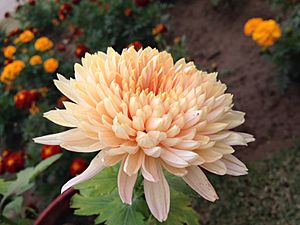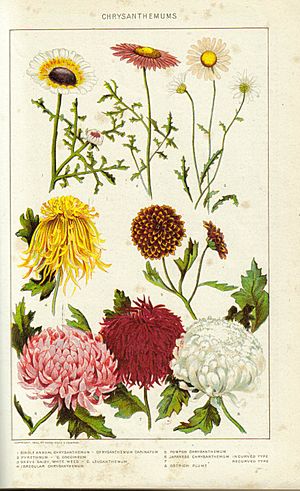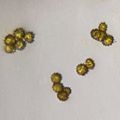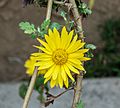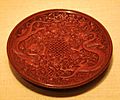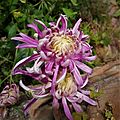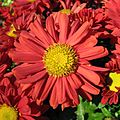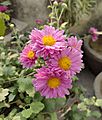Chrysanthemum facts for kids
Quick facts for kids Chrysanthemum |
|
|---|---|
 |
|
| A cluster of chrysanthemums | |
| Scientific classification | |
| Kingdom: | |
| Division: | |
| Class: | |
| Order: | |
| Family: | |
| Genus: |
Chrysanthemum
|
| Species | |
|
Chrysanthemum aphrodite |
|
Chrysanthemums, often called mums or chrysanths, are beautiful flowering plants. They are a type of perennial plant, meaning they live for more than two years. Mums belong to the daisy family, Asteraceae. There are about 30 different kinds, or species, of chrysanthemums. These lovely flowers originally came from Asia and northeastern Europe. Mums are known for their bright colors and many petals. They are popular garden plants all over the world.
Contents
History of Chrysanthemums
Chrysanthemums have a long and interesting history. People in China first started growing them as far back as the 15th century BC. They were used as a flowering herb. An old Chinese city was even named Ju-Xian, which means "chrysanthemum city." This shows how important they were.
Around the 8th century AD, chrysanthemums arrived in Japan. The Emperor of Japan loved the flower so much that he made it his official seal. Japan even has a special "Festival of Happiness" that celebrates these flowers.
Modern Chrysanthemums
Today's chrysanthemums look much fancier than their wild ancestors. Their flowers come in many different shapes. Some look like daisies, while others are round like pompons or small buttons. You can find mums in many colors, not just yellow. They also come in white, purple, and red.
Each chrysanthemum bloom is actually made up of many tiny individual flowers called florets. Each floret can produce a seed. The disk florets are found in the center of the flower head. The ray florets are the ones that form the petals around the outside.
Uses of Chrysanthemums
In some parts of Asia, people boil yellow or white chrysanthemum flowers to make a sweet drink. This drink is simply called "chrysanthemum tea". Chrysanthemum tea is believed to help people recover from the influenza (flu). The leaves of chrysanthemum plants are also steamed or boiled and eaten as greens. They are especially popular in Chinese cooking.
A type of chrysanthemum called Pyrethrum (Chrysanthemum cinerariaefolium) is very important. Its flowers are used to make a natural insecticide. The flowers are crushed, and special parts called pyrethrins are taken out. These pyrethrins are considered safe to use around food.
Did you know that chrysanthemum plants can also help clean the air? A study by NASA showed that they can reduce indoor air pollution.
Cultural Meanings of Chrysanthemums
Chrysanthemums have different meanings in various countries. In some parts of Europe, like France, Italy, Poland, and Croatia, white chrysanthemums are a symbol of death. They are often used for funerals or placed on graves. Similarly, in China, Japan, and Korea, white chrysanthemums can mean sadness or grief.
However, in other countries, the flower represents honesty. In the United States, chrysanthemums are usually seen as positive and cheerful flowers.
Images for kids
-
Example of a Japanese bonsai chrysanthemum
-
Ming dynasty red lacquerware dish with carved chrysanthemums and dragons
-
The scabbard of a wakizashi with chrysanthemums painted using maki-e, a decoration technique of Japanese lacquerware. 18th century, Edo period.
-
Outer Kimono for a Young Woman (Uchikake). Motif: Chrysanthemums and fences.
-
Chrysanthemum crest on the battleship Mikasa
-
Maki-e Sake Ewer with Chrysanthemums and Paulownia Crests in Alternating Fields. early 17th century, Azuchi–Momoyama period.
See also
 In Spanish: Crisantemo para niños
In Spanish: Crisantemo para niños


